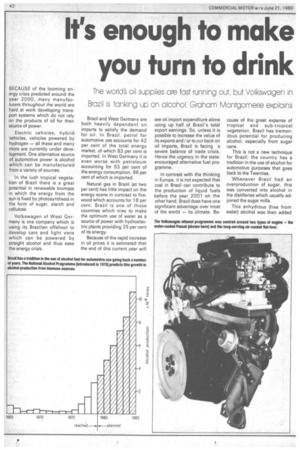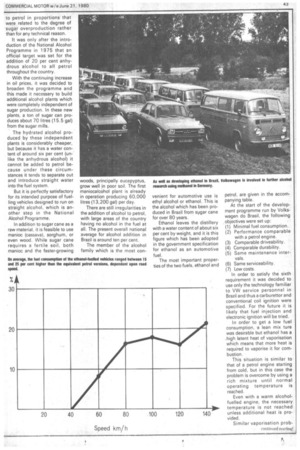It's enough to make you turn to drink
Page 44

Page 45

If you've noticed an error in this article please click here to report it so we can fix it.
BECAUSE of the looming energy crisis predicted around the year 2000, many manufacturers throughout the world are hard at work developing transport systems which do not rely on the products of oil for their source of power.
Electric vehicles, hybrid vehicles, vehicles powered by hydrogen — all these and many more are currently under development. One alternative source of automotive power is alcohol which can be manufactured from a variety of sources.
In the lush tropical vegetation of Brazil there is a great potential in renewable biomass in which the energy from the sun is fixed by photosynthesis in the form of sugar, starch and cellulose.
Volkswagen of West Germany is one company which is using its Brazilian offshoot to develop cars and light vans which can be powered by straight alcohol and thus ease the energy crisis. Brazil and West Germany are both heavily dependent on imports to satisfy the demand for oil. In Brazil, petrol for automotive use accounts for 42 per cent of the total energy market, of which 83 per cent is imported. In West Germany it is even worse with petroleum accounting for 53 per cent of the energy consumption, 96 per cent of which is imported.
Natural gas in Brazil (at two per cent) has little impact on the energy scene in contrast to firewood which accounts for 18 per cent. Brazil is one of those countries which tries to make the optimum use of water as a source of power with hydroelectric plants providing 25 per cent of its energy.
Because of the rapid increase in oil prices it is estimated that the end of this current year will see oil import expenditure alone using up half of Brazil's total export earnings. So, unless it is possible to increase the value of its exports and/or to cut back on oil imports. Brazil is facing a severe balance of trade crisis. Hence the urgency in the stateencouraged alternative fuel programme.
In contrast with the thinking in Europe, it is not expected that coal in Brazil can contribute to the production of liquid fuels before the year 2001 on the other hand, Brazil does have one significant advantage over most of the world — its climate. Be cause of the great expanse of tropical and sub-tropical vegetation, Brazil has tremendous potential for producing alcohol, especially from sugar cane.
This is not a new technique for Brazil; the country has a tradition in the use of alcohol for automotive purposes that goes back to the Twenties.
Whenever Brazil had an overproduction of sugar, this was converted into alcohol in the distilleries which usually adjoined the sugar mills.
This anhydrous (free from water) alcohol was then added
to petrol in proportions that were related to the degree of .sugar overproduction rather than for any technical reason.
It was only after the introduction of the National Alcohol Programme in 1975 that an official target was set for the addition of 20 per cent anhydrous alcohol to all petrol throughout the country.
With the continuing increase in oil prices, it was decided to broaden the programme and this made it necessary to build additional alcohol plants which were completely independent of sugar production. In these new plants, a ton of sugar can produces about 70 litres (15.5 gal) from the sugar mills.
The hydrated alcohol produced by these independent plants is considerably cheaper, but because it has a water content of around six per cent (unlike the anhydrous alcohol) it cannot be added to petrol because under these circumstances it tends to separate out and introduce straight water into the fuel system.
But it is perfectly satisfactory for its intended purpose of fuelling vehicles designed to run on straight alcohol, which is another step in the National Alcohol Programme.
In addition to sugar cane as a raw material, it is feasible to use manioc (cassava), sorghum, or even wood. While sugar cane requires a fertile soil, both manioc and the faster-growing woods, principally eucapyptus, grow well in poor soil. The first maniocalcohol plant is already in operation producing 60,000 litres (13,200 gal) per day.
There are still irregularities in the addition of alcohol to petrol, with large areas of the country having no alcohol in the fuel at all. The present overall national average for alcohol addition in Brazil is around ten per cent.
The member of the alcohol family which is the most con venient for automotive use is ethyl alcohol or ethanol. This is the alcohol which has been produced in Brazil from sugar cane for over 80 years, Ethanol leaves the distillery with a water content of about six per cent by weight, and it is this figure which has been adopted in the government specification for ethanol as an automotive fuel.
The most important properties of the two fuels, ethanol and petrol, are given in the accompanying table.
At the start of the development programme run by Volkswagen do Brasil, the following • objectives were set up: (1) Minimal fuel consumption.
(2) Performance comparable with a petrol engine.
(3) Comparable driveability.
(4) Comparable durability.
(5) Same maintenance intervals.
(6) Same serviceability.
(7) Low costs.
In order to satisfy the sixth requirement it was decided to use only the technology familiar to VW service personnel in Brazil and thus a carburettor and conventional coil ignition were specified. For the future it is likely that fuel injection and electronic ignition will be tried.
In order to get a low fuel consumption, -a lean mix ture was desirable but ethanol has a . high latent heat of vaporisation which means that more heat is required to vaporise it for combustion.
This situation is similar to that of a petrol engine starting
from cold, but in this case the problem is overcome by using a rich mixture until normal operating temperature is reached.
Even with a warm alcoholfuelled engine, the necessary temperature is not reached unless additional heat is provided.
Similar vaporisation prob




























































































































